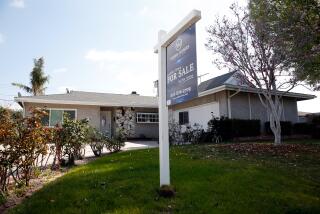Made to Order
About 50 miles east of Los Angeles, near the junction of Interstates 15 and 210 in Rancho Cucamonga, KB Home Corp. crews are erecting tract houses on land that once neighbored a grimy steel mill.
Prices start at just under half a million dollars, and KB Home already has sold more than half of the 117 houses on the drawing board for the site, called Lexington at Etiwanda.
That says a lot about Southern California’s sizzling housing market. So does KB Home’s construction plan: It won’t start on the rest of the houses until after it sells them.
The Westwood-based company and other home builders are taking a cautious approach these days, even though demand is feverish. In fact, “we have no completed inventory of houses -- zero,” said Wade H. Cable, president of William Lyon Homes in Newport Beach.
Home builders are wary because they remember what happened 15 years ago, when they badly misjudged the end of the region’s last housing boom. They didn’t see it coming, and when California’s economy tanked in the late 1980s and early 1990s, builders were stuck with tens of thousands of uncompleted houses and empty lots, sending the industry into a financial tailspin.
Having learned a painful lesson, builders today get out their hammers and nails only after they have secured buyers. That caution is one reason the supply of housing in Southern California remains short of demand. And that, in turn, is a key reason prices have soared into the stratosphere.
“We were a lot more speculative 10 years ago,” said Jeffrey T. Mezger, KB Home’s chief operating officer. Today, “we’re not even close to keeping up with demand in the state of California.”
Consider: Builders in Southern California ended last year with 2,145 single-family houses and condominiums that were either under construction or completed, compared with 23,389 in 1990, according to Meyers Group Real Estate Information Inc., a research firm in Irvine.
At the same time, the median price of a new single-family house last year hit a record $437,323 in Los Angeles County, and in Orange County it reached $706,353, according to Meyers Group. (The median means half the houses sold for less than that amount, and half for more.)
Prices are still rising. The median reached $493,323 in Los Angeles County in this year’s first quarter and $758,500 in Orange County, Meyers Group said.
Better Return on Assets
Yet the soaring prices haven’t dented sales. In April, the most recent month for which data were available, sales of new and existing Southern California dwellings shot up more than 20% from a year earlier to 32,916 units, according to DataQuick Information Systems Inc. It was the busiest April since the San Diego firm began keeping records in 1988.
In another example of the builders’ restraint, they have yet to surpass their annual sales of 15 years ago. Sales of new houses and condos last year totaled 57,441, compared with 64,446 sold in 1988, according to DataQuick.
Even so, the region’s boom, combined with the builders’ own attention to better cost controls and financial management, has fattened builders’ profits and stock prices.
“The nature of the building industry has shifted from a highly entrepreneurial, speculative, let’s-carry-the-land-on-the-books kind of business to a more refined, Wall Street-oriented business that looks very carefully at its return on assets,” said Richard Gollis, a principal of the Concord Group, a real estate advisory firm in Newport Beach.
Builders such as KB Home, Calabasas-based Ryland Group Inc. and William Lyon Homes continue to post double-digit percentage gains in quarterly earnings and sales. In the last four years, KB Home’s stock price has tripled, Ryland’s has jumped eightfold, and shares of William Lyon Homes -- which was among the hardest-hit builders in the early 1990s -- have soared 18-fold since early 2000.
The stocks have been under some pressure since rates on conventional 30-year, fixed-rate mortgages began climbing past 6% in March. And in April, the number of houses under construction nationwide slipped 2.1% from a month earlier, the U.S. Commerce Department reported, indicating that the overall domestic housing market was cooling slightly.
Southland Still Sizzling
But in Southern California, builders and analysts said, the market remains as hot as ever. Interest rates, though moving up, remain relatively low, while the strong U.S. economy and an improving job market continue to support sales.
“Better job growth is good for housing demand,” analyst Carl Reichardt of Wachovia Securities said in a report last month.
Reichardt noted that the number of completed new houses nationwide “represents about three weeks of total supply, an all-time low.”
Still, builders here are “selling everything they’re building,” said John Karevoll, an analyst at DataQuick. Rates on 30-year, fixed-rate mortgages “would have to go up quite a bit more before we get into danger, probably 7.5% to 8% in Southern California,” he said.
Even if that happens, home builders “are much less at risk than they were 15 years ago,” Karevoll said.
The business was dramatically different then. Builders borrowed heavily, often using short-term loans, to construct multiyear projects. They gobbled up empty land and built more on “spec,” meaning speculative housing that they hoped would attract buyers.
“We would start 20, 40, 60 homes in a subdivision and then try to sell them,” said Mezger of KB Home.
When the economy and housing market cratered in the late ‘80s and early ‘90s, the strategy backfired.
Lenders called in their loans, and many builders were suddenly dangerously low on cash. Companies such as Lyon had to slash the value of their land holdings, making it difficult to secure fresh financing.
New-home sales in Southern California, which had reached 79,526 in 1988, plunged 64% in the next seven years to just 29,009 in 1995, according to Meyers Group.
Many smaller builders failed or were acquired by larger companies such as Lennar Corp. of Miami, whose Southern California divisions now include Greystone Homes and U.S. Home. Those that survived, such as KB Home, gobbled up as much cheap land as they could in preparation for the next upswing.
Supply Imbalance
The turnaround arrived in the last few years, as lending rates fell to their lowest level in four decades and a surging immigrant population swelled the number of potential buyers. In 2000, one analyst said the builders were headed toward “perhaps the most favorable macroeconomic and demographic climate for homeownership in more than 30 years.”
He was right. Now “supply and demand is grossly out of balance here,” said Cable of William Lyon Homes. Its backlog -- homes sold but that had yet to close escrow -- hit a record 1,755 in the quarter ended March 31, up 64% from a year earlier.
If interest rates keep edging higher, there is “an array of mortgage products” with adjustable-rate features that will help keep stoking demand for houses, Cable said.
“A home buyer can choose from any number of methods that are not just strictly a 30-year, fixed-rate mortgage.”
That said, a buyer has to sign on the dotted line before a builder will put a shovel in the ground.
“We’re far more sensitive to the cycle than in the past,” said KB Home’s Mezger.
“If the market were to slow, we would just slow down the pace.”
More to Read
Inside the business of entertainment
The Wide Shot brings you news, analysis and insights on everything from streaming wars to production — and what it all means for the future.
You may occasionally receive promotional content from the Los Angeles Times.











